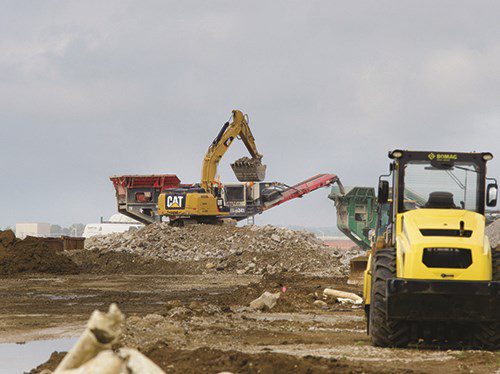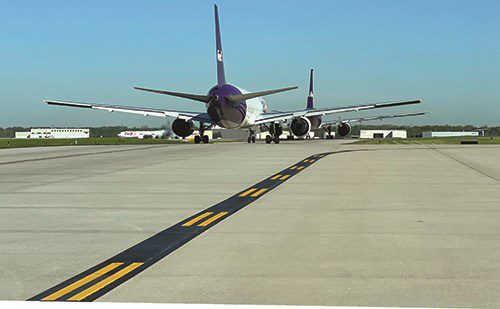Indianapolis International Airport (IND) is the eighth-largest cargo facility in the U.S. and home to the world’s second-largest FedEx operation—not to mention its 8 million annual passengers. With that kind of traffic on two parallel primary runways, airfield improvements require careful planning and coordination.
Indianapolis International Airport (IND) is the eighth-largest cargo facility in the U.S. and home to the world’s second-largest FedEx operation—not to mention its 8 million annual passengers. With that kind of traffic on two parallel primary runways, airfield improvements require careful planning and coordination.
Last year, IND completed the first phase of a $190 million, three-phase reconstruction program that will completely rebuild Runway 5R-23L and Taxiway D over three years. Both stretches of pavement are integral to operations. The 10,000-foot-long, 150-foot-wide runway supports most of the airport’s cargo operations and is also important for passenger airline traffic. Taxiway D is its full-length parallel connector.
In addition to significantly extending the lifecycle of key airfield assets, the ongoing reconstruction project is also turning heads as the first airfield project in the world to earn an Envision Platinum Award, the highest recognition for sustainability and resiliency from the Institute for Sustainable Infrastructure.
|
facts&figures Project: Runway & Taxiway Reconstruction Location: Indianapolis Int’l Airport Owner/Operator: Indianapolis Airport Authority Project Scope: About 450,000 sq. yds. of pavement on Runway 5R-23L & Taxiway D Total Est. Cost: $190 million Funding: $56 million FAA Airport Improvement Program grant; airport capital improvement funds Phase 1: April 2022-Dec. 2022 Phase 2: April 2023-Oct. 2023 Phase 3: April 2024-Oct. 2024 Project Design/Engineering: Circle City Aviation Partners, joint venture of Woolpert & Kimley-Horn Package 1 Contractor: Walsh Construction Package 2 Contractor: Milestone Contractors Package 3 Contractor: To be determined Sustainability: C&S Companies Carbon Capture Technology: CarbonCure Runway Lighting & Power Design: Loftus Engineering Storm Sewer Design: Wessler Engineering Utilities & Site Design: Infrastructure Engineering Navigational Aids: Aviation Alliance Cost Estimation & Scheduling: Connico Geotechnical & Quality Assurance: CTL Engineering Construction Phase Services: B&R Consulting; Journey Engineering Key Sustainability Features: LED lighting & signage; recycled concrete in runway base; FAA-approved concrete mix design that includes carbon sequestration; onsite concrete crushing (to reduce associated road traffic); noise, light & visual impact mitigation for surrounding properties Noteworthy Details: 1st airfield project in world to earn Envision Platinum certification from Institute for Sustainable Infrastructure; adding 1 extra inch of concrete (to create 22-inch top layer) increased estimated lifespan of pavement from 20 to 30 years |
Phase One was completed last December, Phase Two is currently in the works, and the final Phase Three is scheduled for next year.
No Stone Unturned
Runway 5R-23L originally began supporting operations in 1989. It has been maintained and rehabilitated over the years, but inevitably reached the end of its useful life. When the pavement was nearly 30 years old, the airport knew it needed to be replaced or reconstructed, explains Jarod Klaas, senior director of Planning and Development for the Indianapolis Airport Authority. “The design life was 20 years, and that speaks a lot to the maintenance team here and how they care for the infrastructure,” he adds. “They managed to get significantly longer than the design life out of the pavement.”
In 2018, IND began a programming effort to explore existing conditions and possible solutions. Circle City Aviation Partners, a joint venture of Woolpert and Kimley-Horn, handled project design and engineering.
Basically, the airport instructed Circle City Aviation Partners to leave no stone unturned. “And that’s exactly what we did,” recalls Nate Summers project manager with Kimley-Horn. “We explored everything.”
That diligence produced 50 possible solutions for rehabilitating or reconstructing the targeted runway and taxiway. “But we knew early in the preliminary design that only a few would continue to the final phase of analysis,” adds Tony Esposito, the project pavement engineer with Kimley-Horn.
In addition to cost and constructability, resiliency and sustainability were key factors for analyzing the various options. “IND really challenged our team early on to consider resiliency—to make sure the airport was spending money wisely and that the project would meet and exceed FAA requirements—and sustainability on all fronts,” explains John Baer, a senior associate with Woolpert.
After extensive analysis, a full-depth concrete reconstruction was the “clear-cut winner” for IND’s sustainability, durability and operational needs, says Baer.
Existing runway pavement was removed down to dirt, and the top 8 inches were stabilized to provide a solid platform for building the rest of the section. Early in the process, nondestructive testing indicated that subgrade improvements were needed to control under-pavement moisture. Test results also prescribed the installation of underdrains and other utility improvements. The new runway pavement is made up of 6 inches of recycled stone made from the existing concrete pavement, 5 inches of asphalt and 22 inches of concrete. Dowel bars tie the concrete together and provide load transfer—a necessity driven by the addition of Boeing 777s to the FedEx fleet.
 “We had a lot of constraints, given that one of the biggest tenant’s cargo facility is adjacent to that parallel taxiway,” notes Shannon Gunn, a civil engineer at Kimley-Horn. “To phase the project we had to divide the project into three separate packages to have constructable pieces that would limit operational impacts.”
“We had a lot of constraints, given that one of the biggest tenant’s cargo facility is adjacent to that parallel taxiway,” notes Shannon Gunn, a civil engineer at Kimley-Horn. “To phase the project we had to divide the project into three separate packages to have constructable pieces that would limit operational impacts.”
The airport spent roughly 24 months working with the FAA to identify and secure funding for the project, and the availability of funding altered its original schedule. When IND received a higher level of funding than anticipated for Phase 1, it adjusted course and completed the larger Phase 2 first.
During the new Phase 1, crews reconstructed about 7,000 feet of the runway and parallel taxiway—including the full removal and replacement of pavement, installation of new drainage systems and upgrades to adjacent navigational aids. Existing storm pipe was also rehabilitated with cured-in-place pipe, adding 50 years of service life to existing lines.
The second phase (originally Phase 1) kicked off this April and is expected to be complete in October. Crews are reconstructing another 1,500 feet on the west end of the runway, and upgrading the localizer, lighting and drainage infrastructure. Phase 3, scheduled for next year, will address the east end of the runway, with similar improvements plus the installation of LED lights. Taxiway N will also be realigned during Phase 3.
Collaboration and Carbon Capture
 Among the project leadership team, there were not only discussions about enhancing the operational capabilities and durability of the runway, but also leveraging organizational initiatives—especially sustainability. “We took a long look at what we could do from an environment front on this piece of pavement,” Klaas says.
Among the project leadership team, there were not only discussions about enhancing the operational capabilities and durability of the runway, but also leveraging organizational initiatives—especially sustainability. “We took a long look at what we could do from an environment front on this piece of pavement,” Klaas says.
The overall goal was to reduce the carbon footprint of the project by 15%, which roughly equates to planting 1.2 million trees.
To that end, C&S Companies partnered with Circle City Aviation Partners early in the design process to identify sustainability opportunities that could help secure Envision Platinum certification. The idea to use carbon capture was one of the most innovative ideas that emerged.
The process, executed by CarbonCure, introduces recycled, post-industrial carbon dioxide into fresh concrete to reduce its carbon footprint without compromising the pavement’s performance. During the batching process, gaseous carbon dioxide injected into the drum initiates a chemical reaction that causes the carbon to mineralize with calcium oxides in the concrete before it is poured at the project site. Carbon gas that would have been released into the atmosphere is instead mineralized as a solid that is permanently embedded in the concrete, thus reducing associated greenhouse gas emissions.
 Because IND was the first to use carbon capture technology for an FAA-funded runway project, there were extra hoops to jump through to ensure the pavement would meet FAA standards for performance and funding eligibility. “There was a lot of engagement with FAA,” Summers relates. “We listened to their concerns and worked to write a standard they would accept—but it didn’t happen overnight. It was a true technical team effort from the Airport Authority, our design team and a partnership with FAA.”
Because IND was the first to use carbon capture technology for an FAA-funded runway project, there were extra hoops to jump through to ensure the pavement would meet FAA standards for performance and funding eligibility. “There was a lot of engagement with FAA,” Summers relates. “We listened to their concerns and worked to write a standard they would accept—but it didn’t happen overnight. It was a true technical team effort from the Airport Authority, our design team and a partnership with FAA.”
The project team did its homework, adds Tony McMichael, director of Airside Development for the Indianapolis Airport Authority. “We made sure that we collaborated with the industry ahead of going to the FAA.”
In particular, IND reached out to other industries that have used carbon capture technology to understand potential challenges. “It is the collaboration that allowed this to happen,” McMichael emphasizes.
“That’s where innovation comes in,” agrees Klaas. “We learned some things from those that went before us, and we did some things differently. What we achieved here was not only about improving infrastructure, but doing things in the most sustainable way.”
While introducing carbon dioxide into the concrete mix isn’t expected to enhance the performance of IND’s new pavement, it demonstrates that the green strategy has a place in airfield infrastructure. “We had faith in this technology, and that we could show the way for other airports to do things differently to benefit the environment and achieve carbon neutrality,” McMichael says. “It was really about that initiative as opposed to engineering benefits from the carbon capture.”
Gunn notes that introducing this technology helps advance sustainability and conversations about carbon footprints within the industry. As the first airport in the world to achieve Envision Platinum status for an airfield project, IND definitely punctuates the point.
 Although carbon capture is new to the industry, it wasn’t so foreign that it slowed progress at the jobsite. “The contractor was able to pour the concrete just like it normally would,” Esposito explains. “And beyond the specification language, we didn’t
Although carbon capture is new to the industry, it wasn’t so foreign that it slowed progress at the jobsite. “The contractor was able to pour the concrete just like it normally would,” Esposito explains. “And beyond the specification language, we didn’t
have to modify anything else in our design documents to include this technology.”
But carbon capture wasn’t the only initiative that led to Platinum Envision certification. With IND leadership stressing sustainability for all aspects of the runway and taxiway reconstruction, the project team incorporated several other environmentally friendly strategies:
- recycling existing concrete to use as build base for the new runway pavement;
- crushing concrete onsite to reduce traffic on local roads;
- using non-potable water instead of hydrant water for dust control in the aggregate base and other appropriate areas;
- upgrading to more efficient LED airfield lighting; and
- donating signage and lighting removed during the project to the Indiana Department of Transportation, Aviation Division for use at other airports.
Engineers also specified trapezoidal grooves, rather than traditional straight channels, because they are designed to reduce the amount of rubber required to maintain the same amount of runway surface friction. “We’re anticipating with the introduction of trapezoidal grooving, we’ll have less frequent rubber removal operations, which results in less frequent runway closures and abrasive forces and longer-lasting concrete pavement,” Esposito explains.

Minimizing Operational Impact
Due to the vital role that Runway 5R-23L plays at IND, considerable time was invested working with tenants, airport operations personnel and other stakeholders to reduce disruptions during the reconstruction.
 Phasing the project over three years was key to ensuring constructability, maximizing the availability of funding and minimizing the impact on airport users. “It was a long process that involved a great deal of collaboration with our stakeholders to ensure that the airfield remains operational to the fullest extent possible,” explains Drew Genneken, deputy senior director of Planning and Development at the Airport Authority.
Phasing the project over three years was key to ensuring constructability, maximizing the availability of funding and minimizing the impact on airport users. “It was a long process that involved a great deal of collaboration with our stakeholders to ensure that the airfield remains operational to the fullest extent possible,” explains Drew Genneken, deputy senior director of Planning and Development at the Airport Authority.
In addition to keeping traffic flowing on the busy airfield, the design team had to maintain access to and from FedEx’s facility, which is directly adjacent to the work site. “One of the biggest tenants on the airfield is sitting right next to this project, so we needed to make sure that we were keeping the tenant happy and minimizing disruptions to them, while maintaining a safe environment,” says Esposito. “There was some pretty complex phasing to achieve this because they needed a way around the taxiway under construction to get to the active runways. While safety was always paramount to us, phasing was critical to making sure the tenant had two or three access points to get from the runway to the apron.”
To quell concerns about difficulties for FedEx to maintain its heavy schedule throughout reconstruction, the project team held a real-world simulation during one of the cargo giant’s night sorting sessions. Rather than queuing up at nearby 5R-23L, aircraft taxied to the other primary runway for departure and experienced minimal delays.
Summers emphasizes how beneficial the full-scale exercise was. “A lot of times you don’t get to simulate the phasing scenario in real time, so having FedEx willing to work with us was a very beneficial and cool experience,” he remarks.
With IND’s goals heavily rooted in sustainability, planners and designers focused on ensuring that the pavement would last for as long as possible and require the least amount of maintenance. Often, runway pavement lasts about 20 years, but this design is expected to give IND at least 30 years of pavement life. “The engineer determined that 21 inches of pavement would be sufficient for a 20-year lifespan. But we learned that by adding 1 inch, we could gain another 10 years,” notes Genneken.
Project Visibility
 Although the public often shows less interest in airfield improvements than terminal projects, community outreach is a foundational pillar at IND. “We were able to really expose this project to the public,” McMichael notes. Engineering students from Purdue University, members of the American Concrete Pavement Association and several community organizations have spent time at the airport learning about the value this runway and taxiway project will bring to the region.
Although the public often shows less interest in airfield improvements than terminal projects, community outreach is a foundational pillar at IND. “We were able to really expose this project to the public,” McMichael notes. Engineering students from Purdue University, members of the American Concrete Pavement Association and several community organizations have spent time at the airport learning about the value this runway and taxiway project will bring to the region.
The Indianapolis Airport Authority is also proud of the participation by more than 30 local subcontractors. It is slated to spend approximately $38.6 million with 34 diverse businesses during phases one and two, and anticipates more diverse business participation as Phase Three proceeds in 2024.
“We’ve got public-community value in this project,” McMichael comments. “When you get into the weeds, it’s easy to think you’re just pouring concrete. But we’re not. We’re providing livelihoods, and that matters.”
Before the project is complete, planners estimate it will create more than 3,200 jobs.
In a clever show of courtesy to its neighbors and passing motorists, the airport commissioned a local artist to create a 14,000-square-foot mural on the chain link fence that surrounds the project site. Instead of using a standard screen to obscure the construction clutter, IND went the extra mile and beautified the jobsite with a colorful piece of public art. [Check out the Jan./Feb. 2023 issue of Airport Improvement for photos and more details.]
“This project demonstrates what successes you can have when you set out to be intentional and you have the right collaboration,” Klaas reflects. “I’m encouraged to see what happens next. Not only did we achieve the goal we set out to, we really also became a model in a lot of ways for folks that come after us.”



